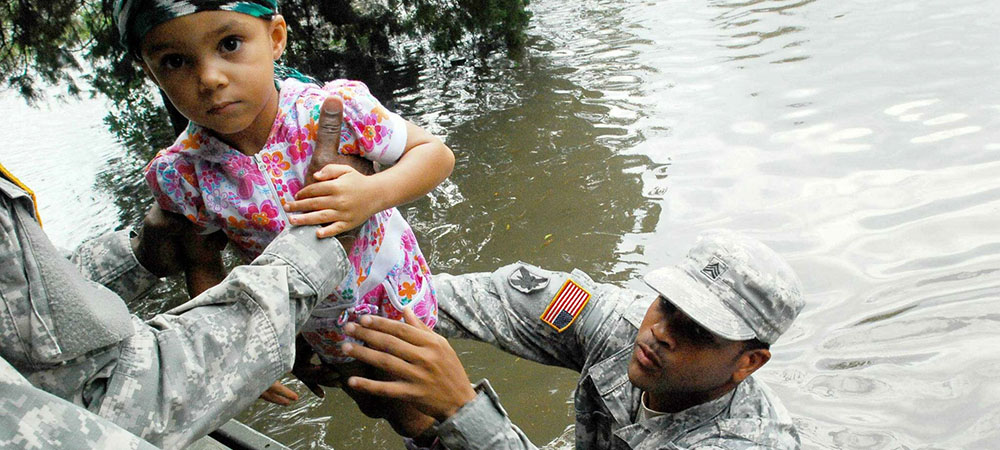 A Louisiana National Guard soldier evacuates a child from flooding caused by Hurricane Isaac. ©Sgt. Rashawn Price, U.S. Army, 2012.
A Louisiana National Guard soldier evacuates a child from flooding caused by Hurricane Isaac. ©Sgt. Rashawn Price, U.S. Army, 2012.
By Betty Lai and Ann-Margaret Esnard
Implications for Public Health
Parents, caregivers, and teachers can take actions to help children cope with the disaster and minimize distress, including limiting media exposure, maintaining routines, and asking children how they’re doing.
Hurricane Harvey highlights how quickly disasters can devastate whole communities. Children, however, need special attention because experiences of trauma and loss can be especially difficult for young survivors. Many young people have traumatic experiences during childhood. In the United States alone, a representative study of children ages 2-17 found that 14 percent reported having been exposed to a disaster. During and after disasters, children may experience scary events, such as needing to be evacuated from a flooded area. They may lose their possessions, and they may not be able to return to their homes.
Social and behavioral scientists have firmly connected disaster exposure with clinically significant distress in children. This distress can include post-traumatic stress symptoms, depression, or anxiety. Post-traumatic stress symptoms could be flashbacks to the event, feeling upset or afraid at reminders of the event, avoiding interacting with friends, or having trouble with sleep. Depression could include experiencing intense sadness, crying, having difficulty engaging in school work, or feeling that nothing is fun or meaningful. Anxiety might include excessive worry, feeling afraid of many things, feeling sick to one’s stomach, or worrying about future events.
Do All Disaster-Exposed Children Report Distress?
Disasters are disruptive by their very nature. The good news is that many children are psychologically resilient after disasters. Recently, we reviewed eight studies of children’s responses to disasters. Across those studies, between 37-79 percent of children were resilient and reported very few negative mental health symptoms. However, between 4 and 38 percent of children across the studies reported severe distress that did not go away over time. These severe distress symptoms sometimes stretched for two years beyond the disaster.
Children at highest risk for experiencing severe, chronic distress include those with histories that make them vulnerable. That could involve experiencing a past disaster, living in a violent community, or having a history of anxiety. The most vulnerable children are also those who experience multiple stressors during and after the disaster, such as having to be evacuated, witnessing destruction, or having to move multiple times. However, stressors that are not directly related to the disaster, such as a parent losing their job, matter as well. Research also shows that children who have severe distress initially after a disaster are more likely to report severe distress over time. As researchers, we are working to integrate findings across disasters so that we can be better prepared to quickly identify the most vulnerable children in future disasters.
How Can Parents and Teachers Help Children Be More Resilient to Disasters?
In light of the body of research regarding children’s trauma and distress, it is important to focus on what can be done to assist young people after disaster.
• Provide information, but make sure it is appropriate for your child’s age. Withholding information about a disaster is scary for children. Children may start to think you are keeping secrets and that things are even worse than they appear.
• Limit media exposure. Exposure to graphic images in the media is linked to distress in children. Limit news exposure of the event so that you are able to monitor the images and information children see.
• Ask your children how they are doing . Do not assume that they feel the same way you do. Children’s reactions do not necessarily match their parents’ reactions.
• Bed-time routines are important. Get children back into their routines as soon as possible. This helps children feel like life is returning to normal. Examples of this include returning to schools when they reopen or returning to a bed time routine.
• Stay connected. Feeling connected to friends and family helps children become more resilient after a disaster. Find ways to help children stay in touch, especially if you have moved to a new location.
• Practice and model coping skills . Show kids many different positive ways to handle stress. Talk to them about what you are doing, and give them opportunities to practice coping skills. For example, “I am feeling really stressed right now about the insurance paperwork. I am going to get a cup of tea. I can come back to this in a little while. Would you like to have a cup of tea with me?”
• Seek help. Disasters are stressful events for everyone, particularly those who have had to evacuate or who are displaced and in limbo. Seek help for yourself or your child if the stress is interfering with your life.
• Encourage your children to take action. Engage youth in disaster preparedness and response activities so they feel a sense of control. For example, children can help develop family communication plans or volunteer to help community or family members in safe environment.
This article originally appeared in the Research Counts series on September 9, 2017. This is an updated version.
Suggested Tools
Tips for Talking to Children and Youth After Traumatic Events
Substance Abuse and Mental Health Services Administration
Guide for parents and educators for talking to children and adolescents after a traumatic event.
Helping Children Cope During and After a Disaster
Centers for Disease Control and Prevention
Resource for parents and caregivers to help children cope after disaster and recognize symptoms of mental distress.
Ready Wrigley Backpack Emergency Card
Centers for Disease Control and Prevention
Emergency contact information card to keep in wallet and child’s backpack.
For a list of all the tools included in this special collection, visit the Children and Disasters Tool Index.

Betty Lai is the Buehler Sesquicentennial Assistant Professor at Boston College. Her work focuses on helping children prepare for, respond to, and adapt to stressors and adverse events. She has identified factors that place children at risk for negative outcomes and factors that help youth be more resilient. She and her colleagues are also examining how adverse events may impact schools. She is working to provide recommendations for how schools may prepare for such events and how they can support their communities.